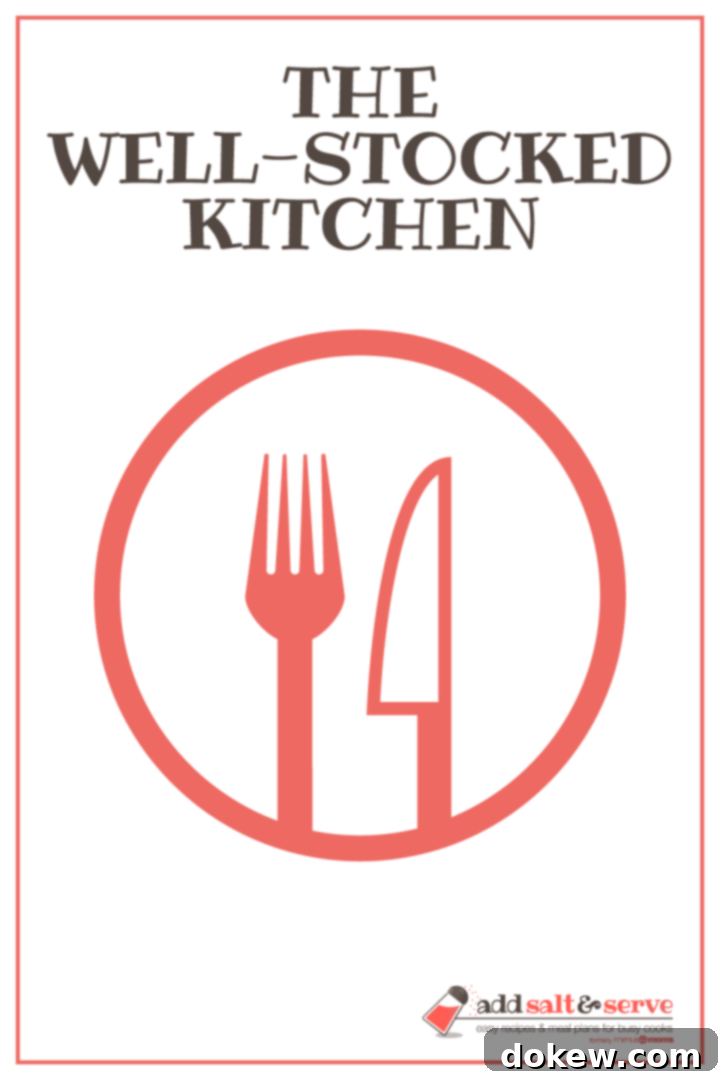Mastering Your Pantry: The Ultimate Guide to a Well-Stocked Kitchen for Savings and Stress-Free Meals
A thoughtfully stocked kitchen is more than just a convenience; it’s a cornerstone of efficient home cooking, leading to significant savings, reduced stress, and the flexibility to prepare delicious meals at a moment’s notice. Imagine avoiding those last-minute dashes to the grocery store or the frustration of realizing you’re missing a key ingredient in the middle of preparing dinner. A well-organized pantry, refrigerator, and freezer empower you to cook more, waste less, and truly enjoy the process.
While no two kitchens will look exactly alike, the principle remains universal: stock what you use often and what brings value to your culinary routine. This guide breaks down the concept of a well-stocked kitchen into three essential categories: non-perishable, refrigerated, and freezer items. Understanding and organizing these areas is crucial, as a fully utilized freezer and refrigerator are just as vital as a robust pantry in maintaining a ready supply of ingredients.
It’s important to approach stocking your kitchen strategically. We don’t advocate for buying everything on these lists at once. Instead, focus on purchasing items you consistently use and gradually build your inventory. The best way to stock up is to replenish your supplies when you find your staple items on sale, slowly creating a comprehensive and cost-effective kitchen inventory over time.
The Power of Your Freezer: Beyond Meats and Veggies
Many home cooks limit their freezer’s potential, typically reserving it for meats, frozen vegetables, and ice cream. However, your freezer is a powerful tool for extending the shelf life of a surprising array of perishable items, transforming them into convenient, ready-to-use ingredients. Embracing freezer stocking for everyday perishables can dramatically reduce food waste and save you money by allowing you to buy items in bulk or when they are on sale.
Consider items you might typically think would spoil quickly. For instance, common dairy products and deli items freeze remarkably well. Lunch meats, pepperoni slices, and various cheeses (shredded or in blocks) can be portioned and frozen until needed. While some cheeses might have a slightly altered texture when thawed, they are perfectly suitable for cooking, melting into casseroles, sauces, or pizzas. Milk can also be frozen in its original container, though it might separate slightly upon thawing; a good shake usually remedies this, making it ideal for baking or cooking. Butter, a pantry staple, stores exceptionally well in the freezer for months, maintaining its quality and flavor.
This mindset extends to fresh produce. Instead of letting onions, peppers, or leafy greens wilt, prepare them for future use. Blanching vegetables like broccoli or spinach before freezing helps preserve their color and nutrients. Sautéing onions and peppers and then freezing them in individual portions provides a ready-made base for countless dishes, including soups, stews, casseroles, and stovetop meals, saving significant prep time during busy weeknights.
To maximize efficiency, I dedicate specific areas in my freezer. For example, a large plastic basket is always filled with various types of shredded and sliced cheese, allowing me to replenish at the best available price without worrying about immediate consumption. Another basket holds pre-sautéed onions, and sometimes green bell peppers, offering instant flavor boosters for a wide range of recipes. Proper labeling with dates is key to ensure you use items in a timely manner and maintain an organized inventory.
Smart Grocery Shopping Strategies: Save Money and Time
Developing the habit of keeping a well-stocked pantry, refrigerator, and freezer is one of the most effective ways to lower your overall grocery bill. This isn’t because you’re buying less food, but rather because you’re making smarter purchasing decisions and paying less for the items you do buy. When your kitchen is already stocked with essentials, you’re not forced to buy items at their current, potentially inflated, prices. Instead, you can patiently wait for sales and special offers, replenishing your supply only when prices are at their lowest.
Here are my best tips for mastering your grocery shopping and maximizing your savings:
-
Shop Your Pantry First
Before you even write a grocery list, “shop” your own pantry, refrigerator, and freezer. This critical first step helps you identify what you already have on hand, preventing duplicate purchases and ensuring that older items are used before they expire. Only after assessing your current inventory should you make a list of what truly needs replenishing, prioritizing items you found on sale.
-
Know Your Prices
Becoming familiar with the typical price range of your staple items is paramount. This knowledge allows you to discern a genuine deal from a perceived discount, as often stores will inflate prices before applying a “sale” label. A simple way to track prices is by using a digital spreadsheet (like Google Sheets) accessible from your phone. Update it at home with regular prices and sales, then reference it while shopping to ensure you’re always getting the best unit price.
-
Don’t Buy What You Don’t Eat
Eliminating food waste is perhaps the single most impactful way to save on groceries. This means being realistic about what your family will consume. Avoid buying large quantities of a sale item if you know you won’t use it before it expires, or if your family simply doesn’t enjoy it. Wishful thinking leads to wasted food and money. Focus on purchasing ingredients that align with your family’s preferences and your established meal plans.
-
Embrace Meal Planning
A well-structured meal plan is the backbone of efficient grocery shopping. By planning your meals for the week, you can create a targeted shopping list that ensures you buy exactly what you need and, crucially, use everything you buy. This eliminates impulse purchases and reduces the likelihood of ingredients languishing in your fridge or pantry until they spoil.
-
Integrate Leftovers into Your Plan
Strategic meal planning extends to intentionally incorporating leftovers. Instead of seeing leftovers as an afterthought, plan to repurpose them for another meal, whether it’s lunch the next day or a transformed dinner later in the week. This not only prevents waste but also saves you time and effort in the kitchen.
-
Weigh Energy Spent vs. Benefit Received
While maximizing savings is important, it’s also crucial to consider the value of your time and energy. Driving to five different stores with a stack of coupons might yield the absolute lowest prices, but the time commitment and fuel costs could outweigh the monetary savings. A more balanced approach often involves comparing prices at 2-3 favorite stores and focusing on getting the best deals on your most expensive or frequently purchased items. This strategy offers significant returns with a reasonable investment of effort.
Beyond traditional supermarkets, discount grocers and outlet-type stores offer incredible opportunities to stock your pantry for less. These establishments often specialize in selling overstocked items, products with slightly dented cans, or items past their “best by” date (which often refers to peak quality, not safety, for many stable goods) at significantly reduced prices. Many operate by selling directly from cases rather than individually stocking shelves, which further reduces their overhead and passes savings onto consumers. While many discount grocers accept EBT cards, most typically do not accept manufacturer coupons, so it’s always wise to check their specific policies.
Smaller chain stores have carved out a niche by offering competitive deals on select items. Retailers like Lidl and Aldi are renowned for their efficient models and deep discounts on a rotating selection of products. Other regional chains, such as Sharp Shopper, provide similar value. Larger discount chains like Save-A-Lot, with over a thousand locations, also offer savings, though perhaps not as steep as some of the more specialized outlets. Even dollar stores can carry groceries, but careful price checking is essential here; some items might be a great deal, while others could be cheaper elsewhere. Always compare unit prices to ensure you’re truly saving money.
Your Personalized Pantry: Crafting Your Essential Stock Lists
Understanding what goes into a truly well-stocked kitchen is a journey that’s unique to every household. While generic lists can provide a starting point, the ideal inventory for your home will be dictated by your family’s eating habits, dietary needs, and culinary preferences. The following sections are designed not as prescriptive mandates, but as a guide to illustrate the foundational categories for my own home’s provisions; your selections will undoubtedly vary.
The core principle remains constant: stock items you genuinely use, and always “shop your stock” first before heading to the grocery store. This cyclical approach ensures that you only replenish when items are on sale, making your pantry a dynamic tool for saving money and reducing waste. By organizing your kitchen into these three categories—non-perishables, refrigerator staples, and freezer essentials—you gain clarity and control over your food supply.
Part 1 of this series delves into the overarching concept of the well-stocked kitchen, laying the groundwork for a more efficient and economical approach to home cooking.
Part 2: The Well-Stocked Pantry: Non-Perishable Items explores the long-lasting staples that form the backbone of any kitchen. This includes everything from grains and pastas to canned goods, spices, and baking ingredients. These items are crucial for creating meals from scratch and provide a safety net for those times you can’t get to the store.
Part 3: Refrigerator Items focuses on the fresh ingredients, dairy, condiments, and other perishables that require refrigeration. This section emphasizes smart storage, rotation, and how to make the most of fresh produce to reduce spoilage and waste.
Part 4: Freezer Items expands on the powerful role of the freezer, detailing not just obvious frozen foods but also how to effectively freeze and store a variety of items—from meats and vegetables to pre-cooked meal components and even many dairy products—to extend their shelf life and enhance mealtime convenience.
By diligently building and maintaining these categories, you’ll transform your kitchen into a powerhouse of efficiency, always ready to inspire delicious, budget-friendly meals. Start small, focus on what you truly consume, and enjoy the profound benefits of a truly well-stocked home.
Pin This Post for Future Reference

